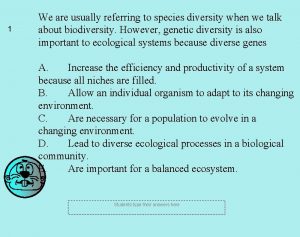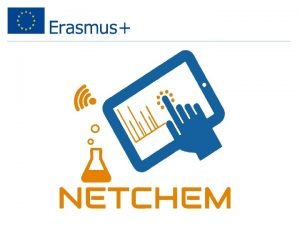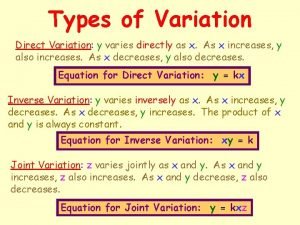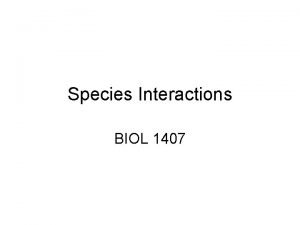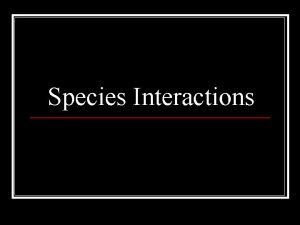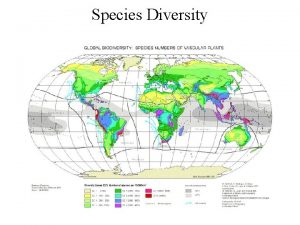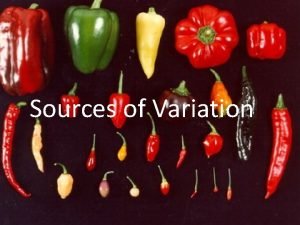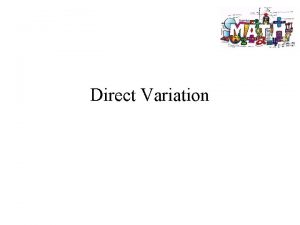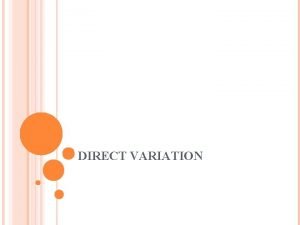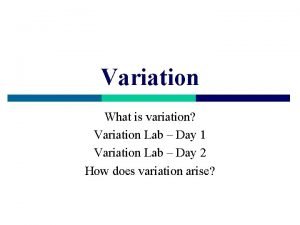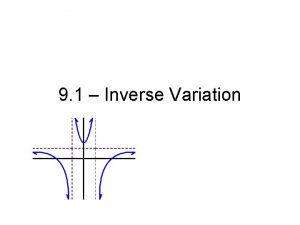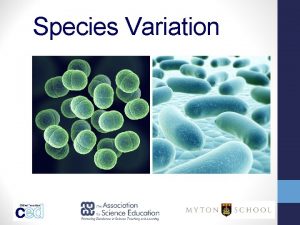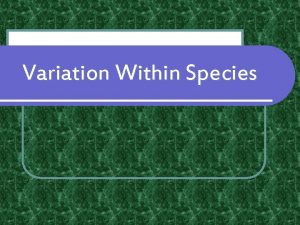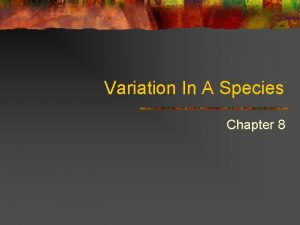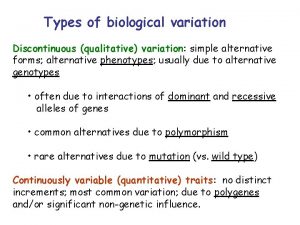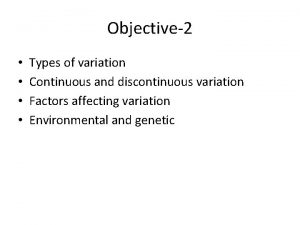Species diversity Species diversity variation in types of


















- Slides: 18

Species diversity • Species diversity: variation in types of organisms present in a community • Components of species diversity – species richness: number of species present – heterogeneity or equitability of species: how equally distributed in the community are the abundances of individual species 1

Measurement of species diversity • Species diversity indices: Table 5 B. 1, p. 178 • Species richness – – number of species in the community simplest estimate count only resident species, not accidentals gives all species same “importance”, regardless of number of individuals present 2

Measurement of species diversity • Heterogeneity of species in the community – attempt to overcome problem of considering common and rare species as having same “importance” in the community – uses relative abundance 3

Measurement of species diversity • Heterogeneity of species in the community – e. g. , two communities with two species and the same total number of individuals could be comprised of two extremes: Species A Species B Community 1 99 1 Community 2 50 50 – heterogeneity increases in a community when there are more species and when the species are equally abundant (heterogeneous) 4

Measurement of species diversity • Shannon-Wiener function – measurement of species diversity using • species richness (number of species) • relative abundance (heterogeneity) H’ = - (pi)[ln(pi)] where H’ = Shannon-wiener index of species diversity s = number of species in the community pi = proportion of total abundance represented by the ith species 5

Measurement of species diversity Shannon-Weiner species diversity calculations for the two 2 -species communities: Community 1 Community 2 N pi ln(pi) pi[ln(pi)] Species A 99 0. 99 -0. 010 50 0. 50 -0. 693 -0. 347 Species B 1 0. 01 -4. 605 -0. 046 50 0. 50 -0. 693 -0. 347 -0. 056 100 Total H’ 100 0. 056 -0. 694 6

Measurement of species diversity • Shannon-Wiener index – values range from near zero to ? ? ? • higher index values indicate higher species diversity • index has no units, has value only when comparing communities – increasing the number of species (s) increases H’ – increasing the equitability (heterogeneity) of the species in the community increases H’ 7

Measurement of species diversity • Evenness – measurement of equitability among species in the community E = H’ / Hmax where E = Pielou’s index of evenness H’ = calculated Shannon-wiener index Hmax = ln(s) = species diversity under maximum equitability conditions s = number of species in the community 8

Measurement of species diversity • Evenness – values range from 0 to 1 – for the two 2 -species communities example: s H’ Hmax E Community 1 2 0. 056 0. 693 0. 081 Community 2 2 0. 694 0. 693 1. 000 9

Measurement of species diversity • Simpson’s index – measurement of dominance and diversity • uses number of species and relative abundance of species • if two individuals are sampled at random within a community, the probability that the two will belong to the same species is I = ni (ni-1) / N (N-1) where ni = number of individuals of the ith species N = total number of individuals 10

Measurement of species diversity • Simpson’s index – the quantity I is a measure of dominance or the concentration of N individuals among s species Ds = 1 - I Ds = 1 – [ ni (ni-1) / N (N-1)] where Ds = Simpson’s dominance index ni = number of individuals of the ith species N = total number of individuals 11

Measurement of community similarity • Jaccard’s coefficient of community similarity CCJ = c / (s 1 + s 2 + sn – c) CCJ = c / S where CCJ = Jaccard’s coefficient of community s 1 = number of species in community 1 s 2 = number of species in community 2 sn = number of species in communities n c = number of species common in all communities S = total number of species found in all communities 12

Experiment 2 • Comparative species diversity – small nekton community associated with salt marshes in the Galveston Bay system – objectives • compare species diversity and species composition at one site (Hance Bayou) between two collection times: October 2010 and September 1999 – – Shannon Weiner diversity Pielou evenness, Jaccard’s coefficient of similarity Simpson’s dominance • compare fish size (age class) among the three sites • compare differences in biotic indices among sites to differences in physical and chemical environment 13

Experiment 2 • Comparative species diversity – variables • water quality – – salinity temperature p. H total dissolved solids (TDS) • physical environment – wind direction and speed – tide level – structures • biological environment 14

You are here! 15

I-45 Virginia Point 3 2 1 Hance Bayou Christmas Bay 16

BIOL 4233 and 5533 Field Trip for Expt 2 Comparative Species Diversity Date: Monday, 10/04/10 Meet at 8: 00 am sharp at the Bright Light bait store just west of the San Luis Pass bridge N Site 3: Virginia Point I-45 To Houston Map is not to scale! West Galveston Bay Galveston Site 2: Hance Bayou Bright Light Bait Store Sportsman's Rd. 61 st St. 8 -mile Stewart Rd. Seawall Blvd. Site 1: Christmas Bay FM 3005 Flashing light Gulf of Mexico San Luis Pass bridge $2 toll each way 17

18
 Genetic diversity vs species diversity
Genetic diversity vs species diversity Ecosystem jigsaw activity
Ecosystem jigsaw activity What is direct variation
What is direct variation Direct and inverse variation graphs
Direct and inverse variation graphs Correlation and regression
Correlation and regression Species
Species Species diversity:
Species diversity: Species diversity:
Species diversity: Biodiversity
Biodiversity Types of direct variation
Types of direct variation Disadvantages of cryopreservation
Disadvantages of cryopreservation Somaclonal variation
Somaclonal variation Language variation and change
Language variation and change Parasitism
Parasitism Wikimedia
Wikimedia 5 major types of species interactions
5 major types of species interactions Concept of species
Concept of species Conclusion of diversity
Conclusion of diversity Variation of light
Variation of light






